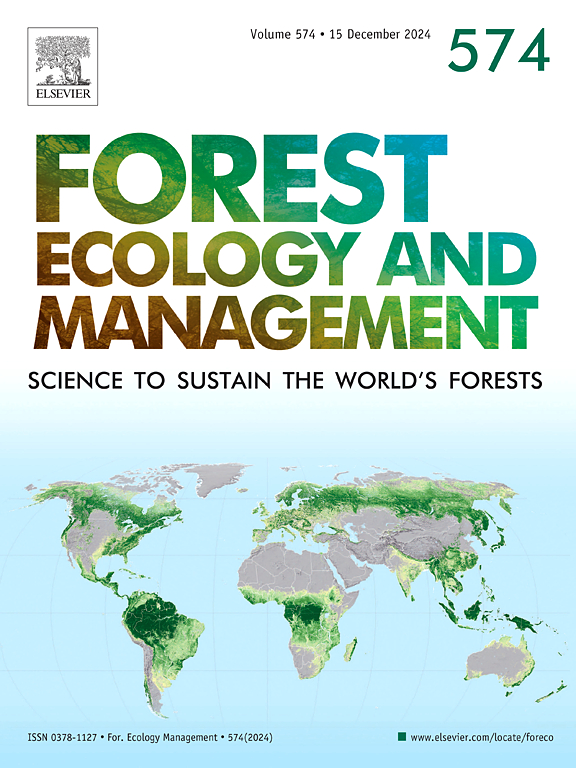Evaluating the potential of Pinus strobus, Pinus nigra, and Pinus rigida as alternatives to Pinus sylvestris in central Europe's changing climate
IF 3.7
2区 农林科学
Q1 FORESTRY
引用次数: 0
Abstract
The observed weakening and dying of Pinus sylvestris in central Europe has prompted a search for species that can replace it. For this purpose, historical late 19th-century survey plots in southern Poland containing Pinus sylvestris and three non-native species, i.e., Pinus strobus, Pinus rigida, and Pinus nigra, were analyzed. The width of annual tree-ring growth was used to measure the effect of climatic variability on tree growth. The climate–growth relationship was analyzed using multivariate methods, linear correlation, and machine learning, which enabled the identification of nonlinearities that would otherwise remain hidden. Temporal variability of these relationships was considered. The pines’ growth was significantly affected by winter temperatures, but March temperature was the dominant growth factor for P. sylvestris, P. rigida and P. nigra. Average March temperatures of 0°C and 5°C were found to be the threshold values, below and above which the effect of temperature on tree-ring growth remained constant. For July precipitation, which is the dominant climatic growth factor for P. strobus, these thresholds were 70 and 120 mm. P. strobus had the largest growth during the analyzed period. High April temperatures for P. rigida, cool May conditions favorable for P. nigra, and low December temperatures beneficial for P. strobus, could serve as distinguishing characteristics for these species under analyzed conditions. Water deficiency in early spring and in the summer negatively affected the growth of all the studied pine species. None of the analyzed non-native species appears suitable for large-scale replacement of P. sylvestris.
在中欧不断变化的气候条件下,评价油松、黑松和刚硬松作为西尔斯特松替代品的潜力
在中欧观察到的西尔维斯特松(Pinus sylvestris)的衰弱和死亡促使人们寻找可以取代它的物种。为此,我们对19世纪后期波兰南部的历史调查样地进行了分析,这些样地包括sylvestris松和3种非本地物种,即strobus松、rigida松和nigra松。利用年轮生长宽度来衡量气候变率对树木生长的影响。使用多元方法、线性相关和机器学习分析了气候增长关系,从而能够识别原本隐藏的非线性。考虑了这些关系的时间变异性。冬季气温对松木生长有显著影响,但3月气温对西林、硬木和黑松的生长有主导作用。3月平均气温为0°C和5°C为阈值,低于和高于该阈值温度对树木年轮生长的影响保持不变。7月降水是水杨的主要气候生长因子,其阈值分别为70和120 mm。在分析期内,水杨的生长量最大。在分析的条件下,4月的高温条件对硬叶藻有利,5月的低温条件对黑叶藻有利,而12月的低温条件对粗叶藻有利,可以作为这些物种的区别特征。早春和夏季水分缺乏对所有树种的生长均有不利影响。所分析的非本土物种中没有一种适合大规模替代林蕨。
本文章由计算机程序翻译,如有差异,请以英文原文为准。
求助全文
约1分钟内获得全文
求助全文
来源期刊

Forest Ecology and Management
农林科学-林学
CiteScore
7.50
自引率
10.80%
发文量
665
审稿时长
39 days
期刊介绍:
Forest Ecology and Management publishes scientific articles linking forest ecology with forest management, focusing on the application of biological, ecological and social knowledge to the management and conservation of plantations and natural forests. The scope of the journal includes all forest ecosystems of the world.
A peer-review process ensures the quality and international interest of the manuscripts accepted for publication. The journal encourages communication between scientists in disparate fields who share a common interest in ecology and forest management, bridging the gap between research workers and forest managers.
We encourage submission of papers that will have the strongest interest and value to the Journal''s international readership. Some key features of papers with strong interest include:
1. Clear connections between the ecology and management of forests;
2. Novel ideas or approaches to important challenges in forest ecology and management;
3. Studies that address a population of interest beyond the scale of single research sites, Three key points in the design of forest experiments, Forest Ecology and Management 255 (2008) 2022-2023);
4. Review Articles on timely, important topics. Authors are welcome to contact one of the editors to discuss the suitability of a potential review manuscript.
The Journal encourages proposals for special issues examining important areas of forest ecology and management. Potential guest editors should contact any of the Editors to begin discussions about topics, potential papers, and other details.
 求助内容:
求助内容: 应助结果提醒方式:
应助结果提醒方式:


